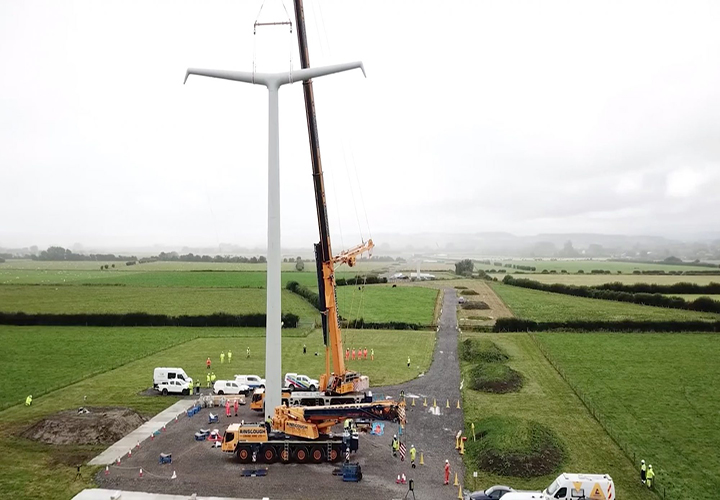 Back
Back

Low carbon
Ainscough developed the lifting plans for the T-pylons, an innovative new pylon for overhead electricity lines, to be lifted into place by client Balfour Beatty. T-pylons have a single pole and T-shaped cross arms, which feature suspension diamond insulators - like ‘earrings’ - which hold the wires, or conductors. 48 of the T-pylons have now been constructed between Bridgwater and Loxton in Somerset and engineers have been putting in place the conductors that will carry the low carbon energy onto the electricity network.
The conductors are transported to the site on large drums, weighing up to 7.5 tonnes and 2.5m high. The lifting team first pull a steel braided rope between sections of up to 12 T-pylons through circular running blocks suspended from the diamond-shaped insulators. The heavier conductors are then attached to the rope via a rectangular headboard.
T-pylons form part of a suite of technologies and approaches to mitigate the visual impact, including alternative lattice pylon designs and different types of underground and subsea cable systems – with each approach chosen where it’s operationally possible and cost-efficient for electricity consumers.
The span of cables between each T-pylon is up to 360m and the conductors are installed in sections of up to 12 T-pylons at a time, with each section taking around two weeks to ‘string’.
Ainscough Crane Hire was appointed by contractor Balfour Beatty to help install the pylons and has been working on the project since Autumn 2021.
The work was undertaken with 250t and 350t cranes from Ainscough’s Cardiff depot and various 150ts from the company’s Bristol and Exeter depots.

Paul Sullivan, project co-ordinator, Ainscough Crane Hire said: “I’ve worked in cranes a long time, and this project has involved some of the most complicated lifting arrangements I’ve been involved in. The amount of gear required from lifting tackle and slings to spreader beams was vast. We had to undertake a tandem lift using the 350t and 150t, lifting the pylons from horizontal to vertical – it was an innovative process and really exciting to be involved in”.
Ainscough was employed on a contract lift basis, with Balfour Beatty‘s own staff slinging and positioning the loads, with Ainscough ensuring they were completed in line with the method statements.
“With a lift programme like this, a significant amount of work went on behind the scenes – along with a great Ainscough team ‘on the ground’ including supervisors David Parfitt and Mark Jones – to ensure the lifts could be completed safely and efficiently. It was then up to the Balfour Beatty team to complete the work, which they did brilliantly,” says Paul.
Throughout the process, Ainscough’s cranes have stayed on-site moving from pylon to pylon in order to install the conductors and diamond-shaped insulators.
Ainscough’s team for the project has included Graham Harrison as the appointed person and National Account Manager Jim McDonnell. Ainscough’s role on the project began several years ago, led by the commercial lead for Hinkley Point C, Adam Hodgkins.
Stringing is now complete on 36 T-pylons between Woolavington and Loxton and work is due to start in April to install the conductors on 12 T-pylons between Bridgwater and Woolavington. These 48 T-pylons will be energised in October 2022.
There will be a total of 116 T-pylons along the route. Construction work has begun on the remaining 68 T-pylons on the northern section of the route between Sandford and Portbury. Those will be completed, including stringing, by 2023.
Ainscough’s involvement in this project began five years ago with the company’s Nottingham depot undertaking an initial trial lift at Eakring when the T Pylons were first designed to confirm lifting configurations and to develop a better understanding and process in preparation for the HPC Connection Project.
As well as the T- Pylons, Ainscough has also assisted with the removal of pylons no longer needed and the installation of temporary bridges to provide access to the T-pylon platforms with cranes ranging from 150t to the TC2800.
Landmark achievement
The Hinkley Connection stretches 57 km from Hinkley Point C to Seabank power station. It is made up of sections of traditional lattice pylons at Shurton and Avonmouth and 116 new T-pylons, with a section of underground cable between Loxton and Sandford, running under the Mendip Hills Area of Outstanding Natural Beauty.
Paul Sullivan concluded: “It’s been a privilege for our team to be involved in what is a landmark achievement for low carbon energy in this country. This was a lift programme that required meticulous planning and close collaboration with our colleagues at National Grid and Balfour Beatty. Throughout, we’ve been committed to using our fleet to enable a nimble and flexible approach that has enabled us to adapt our approach when required.
“This project demonstrates the excellent people we have throughout Ainscough. It was my responsibility to liaise with our contract lift team, our commercial team, and the national hire centre in order to keep things moving on this great undertaking. We were able to do so, and are really proud of how the project has developed. Anyone driving down the M5 will notice how this work has changed the local landscape – a great visual representation of how the country is moving towards low carbon.”
James Goode, Project Director for National Grid Electricity Transmission said: “We’re immensely proud to have reached this significant milestone on the Hinkley Connection Project. National Grid is at the heart of the transition to net zero and the conductors we are installing today will carry low carbon electricity onto the network for millions of people across the UK to use for years to come.”
“The Hinkley Connection Project will be ready to connect six million homes and businesses in the South West and beyond with low-carbon electricity generated by Hinkley Point C and other sources of low carbon energy in 2024 with the project complete, including reinstatement of the land, by the end of 2025.”